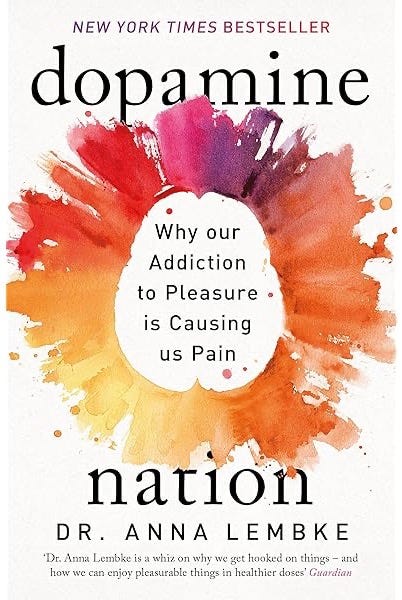In today’s world of instant gratification and constant stimulation, many of us unknowingly fall into cycles of addiction — not just to substances, but to food, technology, entertainment, and even distraction itself. This post explores how modern overconsumption fuels our unhappiness, why avoiding discomfort only deepens our misery, and how true well-being comes from rebalancing the pleasure-pain system in our brain. From the hidden power of abstinence to the healing effects of honesty and community, these key ideas offer a new perspective on breaking free from compulsive behaviors and finding lasting fulfillment.
Key Ideas
Key Idea 1: In an age of compulsive overconsumption, we’ve all basically become pleasure addicts.
Addiction is the sustained, compulsive use of a substance or behavior despite causing harm.
Examples of addicts vary from drug users to those addicted to reading or technology.
Easy access is a significant risk factor for addiction, as seen in the opioid epidemic.
Our modern world offers numerous sources of addiction, including highly processed foods and addictive technologies.
Addiction rates are rising globally, with lifestyle-related risk factors contributing to 70% of deaths.
Key Idea 2: Our misery stems from trying to avoid being miserable.
The aversion to pain has led to a surge in psychiatric medication use, such as antidepressants and stimulants.
Despite unprecedented freedom and progress, people today seem to struggle with unhappiness.
Many individuals are unable to tolerate even slight moments of discomfort, seeking constant distraction and entertainment.
Avoiding pain ultimately leads to a decline in overall well-being.
Confronting boredom and allowing moments of reflection can be beneficial for mental health.
Key Idea 3: Pleasure inevitably leads to pain.
The brain processes pleasure and pain in overlapping regions, striving to maintain balance.
Pleasure often results in craving, leading to a desire for more and building tolerance.
Over time, increased exposure to pleasurable stimuli weakens pleasure and strengthens pain.
This phenomenon is seen in addiction, where addicts need more of the substance or behavior to achieve the same level of pleasure.
The brain's balance may eventually shift to a dopamine deficit state, making individuals more sensitive to pain.
Relapse is common among addicts as they seek to alleviate the discomfort of withdrawal.
With time and effort, the brain can rebalance itself, enabling individuals to enjoy life without addictive substances or behaviors.
These key ideas highlight the author's exploration of addiction, the avoidance of discomfort, and the complex interplay between pleasure and pain in our lives.
Key Idea 4: Abstinence leads to insight.
In a world of abundance, our pleasure-pain balance is skewed, leaving us unsatisfied.
Recovering addicts can provide valuable insights into compulsive overconsumption.
Abstinence from addictive behaviors can lead to clarity and a reset of the reward pathway.
The duration of abstinence may vary depending on the substance or behavior involved.
Abstinence can reveal underlying health conditions and psychiatric disorders.
Key Idea 5: Tipping our scales toward pain can ultimately lead to pleasure.
Exposing oneself to painful stimuli can lead to a balance toward pleasure in the brain.
Gradual exposure to pain makes individuals more immune to it and can create a sense of well-being.
Studies show that moderate exposure to pain can enhance resilience and even extend lifespan.
Activities like intermittent fasting and exercise involve pain but promote well-being.
Key Idea 6: Telling the truth frees us.
Radical honesty is essential for recovery and accountability.
Sharing the truth about our actions allows us to see them in a new light.
Honesty stimulates the prefrontal cortex, aiding in emotional regulation.
Vulnerability and sharing our flaws with others promote intimacy and a sense of security.
Key Idea 7: Prosocial shame gives us the dose of humility we need.
Destructive shame can lead to isolation and repetition of transgressive behavior.
Prosocial shame, embraced by groups like Alcoholics Anonymous, encourages understanding and redemption.
It fosters humility and acceptance within support groups.
Prosocial shame helps individuals realize they are not alone in their imperfections and facilitates compassion.
Final Takeaways
Understand that constant pursuit of pleasure often creates long-term dissatisfaction and emotional imbalance.
Embrace moments of discomfort — boredom, hunger, physical challenge — as essential steps toward building resilience and deeper satisfaction.
Practice abstinence from addictive behaviors to reset your brain’s reward system and rediscover clarity.
Cultivate radical honesty with yourself and others to foster accountability, connection, and emotional growth.
Recognize the value of prosocial shame as a tool for humility, self-awareness, and belonging.
By reshaping our relationship with pleasure, pain, and truth, we can break free from compulsive cycles and create a more grounded, meaningful life.


